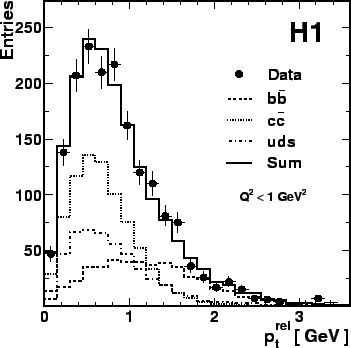Relative Transverse Momentum Distribution
Events with heavy quarks are often identified using
semi-leptonic decays of heavy hadrons. In these events
the decay lepton is typically one of the leading particles in the event.
While a fraction of the decay particles, e.g.the neutrino
escape detection such that the mass of the heavy hadrons can not precisely
be measured, it is nevertheless possible to reconstruct
distributions which reflect the mass of the heavy hadron.
These distributions are significantly different for charm and for
beauty and therefore allow the determination of the relative
contributions from charm and from beauty in a given event sample.
The observable
![]() , i.e. the transverse momentum of the decay lepton
relative to the direction of the parent quark, as estimated by the jet axis,
provides a clear signature for beauty.
Due to their larger mass, events with decays of
, i.e. the transverse momentum of the decay lepton
relative to the direction of the parent quark, as estimated by the jet axis,
provides a clear signature for beauty.
Due to their larger mass, events with decays of ![]() -hadrons
populate higher values of
-hadrons
populate higher values of
![]() as shown in fig.20.
as shown in fig.20.
 |